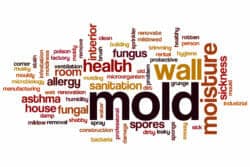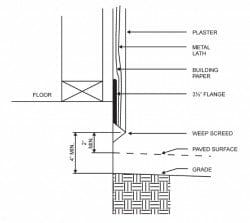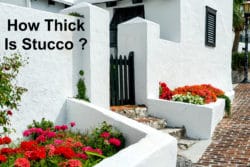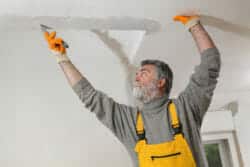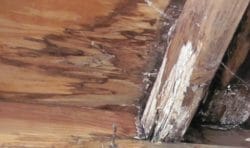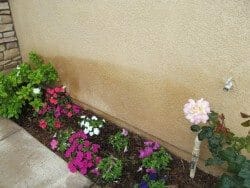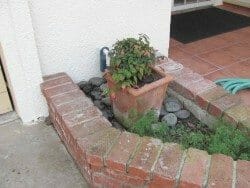How to Tell if Traditional Stucco or EFIS Synthetic Stucco
Homeowners often find it difficult to identify the type of stucco on their house, for it can be tough to tell if you have EFIS, a synthetic stucco system or Traditional Hard Coat stucco; therefore, we want to make it easy for you to tell. One reason it is important is that it affects how you repair cracks and leaks and it may possibly affect your insurance.
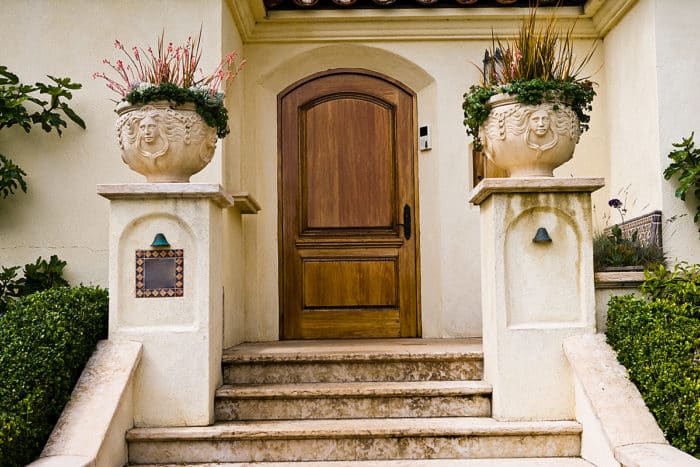
First, one of the most confusing things for many homeowners when they want to know what type of stucco they have is the terminology. For when most people think of stucco, they are generally thinking of 3 layers of stucco cementitious mixes applied over metal wire mesh. The three layers total 7/8 of a inch thick. Whereas EFIS synthetic stucco is something totally different.
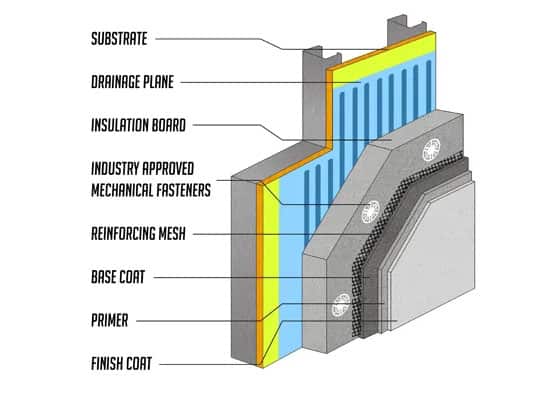
When engineers and contractors are talking about EFIS, they are really talking about a wall system or assembly. EIFS is an acronym for “Exterior Insulation and Finish System.” Another name that pops up at times is “Dryvit.” Dryvit is not a stucco; Dryvit Systems, Inc. is a manufacturer of EIFS products, but remember there are other manufactures of EFIS products as well.
The finish coat on a EFIS synthetic stucco system often looks like traditional stucco but is only about 1/16 of an inch thick: the entire EFIS wall system assembly itself will range between 1 to 4 inches thick including, the foam board and the finish coat.
6 Ways to Tell What Type of Stucco You Have
Always Look for a White Styrofoam Type of Insulation Under The Stucco
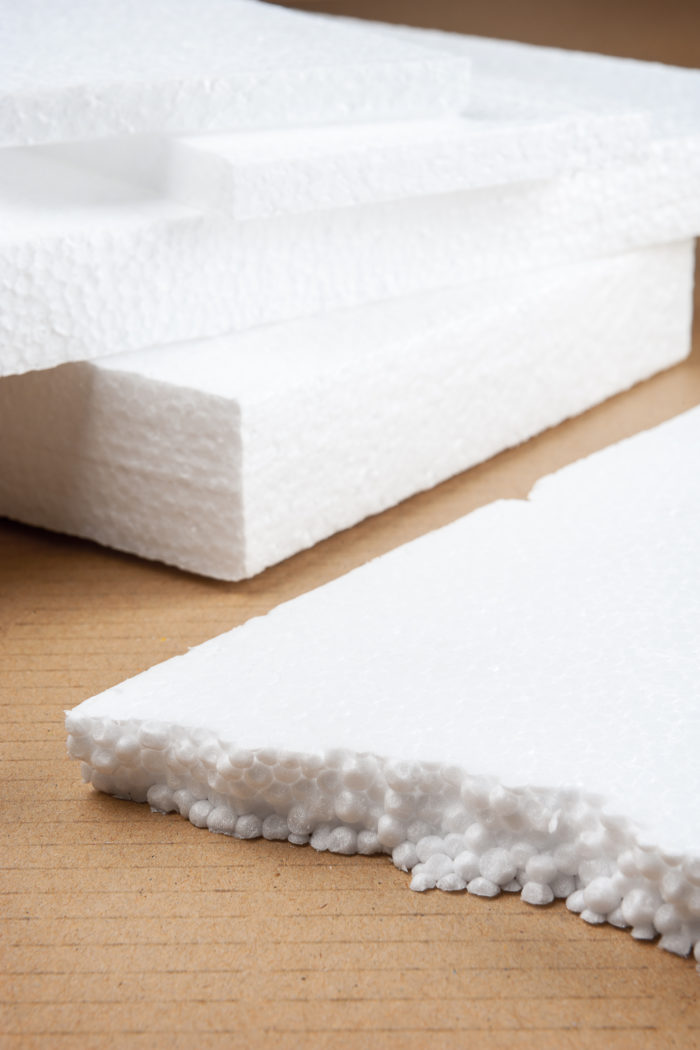
At times you will see small little pieces, chunks or beads of white insulation that have fell out of a gap or hole that you are examining, they often float away with a mild breeze.
If you see a white type of Styrofoam insulation or XPS foam board behind the stucco outer layer or where there are gaps around wall penetrations, then most likely it is an EFIS synthetic stucco system.
The most common method for most people to check for EFIS is to do the “Knock” test, however, there are a number of other ways. They include the following methods or ways. Look them over to see which one is the easiest for you. We have even listed some that we call the “Low Hanging Fruit” ones, for they may be the easiest for you.
#1 The Knock Test
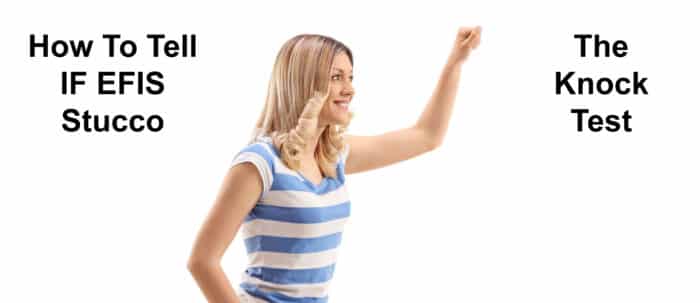
If a Hollow Sound – Most likely EFIS
When knocking on a stucco wall, if there is a hollow type of sound, then it is probably EFIS. If the sound is a type of sound that you might get when knocking on concrete, then it is probably a Traditional hard coat stucco wall.
The “Push” test” / slightly soft or gives a little
If you push on a small area of the stucco wall and there a slight give when pushed on with your thumb or the handle end (not the sharp end) of a screwdriver, then it is usually an EFIS wall. Do not hit the wall, just use a firm but gentle pressure. Hitting it may cause damage or crack the wall.
The wall is very hard
If the wall appears very hard or like it was concrete when doing the push test and the same when doing the “knock test,” it is more than likely to be a Traditional hard coat stucco wall.
Caution
When doing a push test or knocking on a stucco wall be careful not to knock too hard, for the finish texture on stucco is often abrasive and may hurt or skin your knuckles.
#2 Penetrations
Homes have many penetrations in their walls and not all are perfectly sealed, thus you can sometimes see what is behind the outer layer of a wall, especially with an EFIS system because the outer layer is so thin. Sealants or caulking around pipes or other penetrations may have dried out or deteriorated over time, allowing you to peak through the gap and check for signs of white foam board. Some of the typical places that professionals look are:
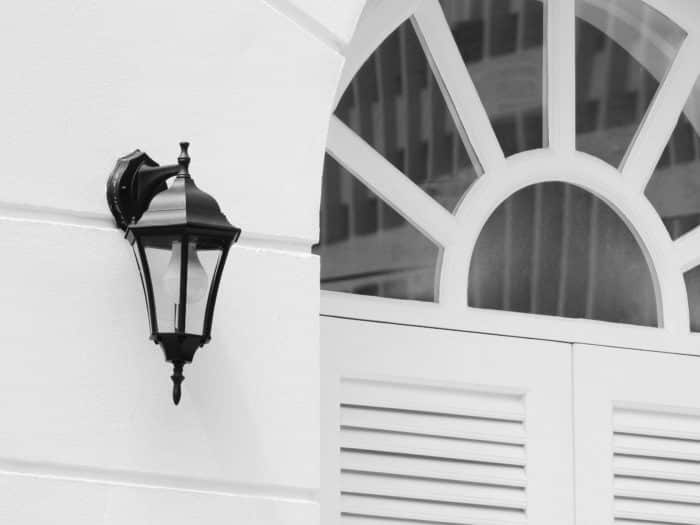
Light fixtures on exterior walls. At times a professional may look behind a exterior light fixture, often removing it or loosening it a little so they can see the hole that the power came through and whether there is white foam board material visible.
Dryer vents in exterior walls. If there is a dryer vent penetrating a stucco wall, you may want to check around it.
Window and door frame areas. There may be small gaps in places around a window or door frame where you can get a glimpse of the materials in the wall.
Other locations to check:
- Hose bibs on exterior walls
- Gas pipes running through a wall
- Water pipes running through a wall
- Doorbells
- Mailbox slots in exterior walls
- Kitchen stove vents on exterior walls
- Small exhaust fans on exterior walls
Over the years the caulking around many of these items has dried up, shrank or deteriorated and fell out; letting you see if there is any evidence of white foam board. If you remove the cover on some of these items, you may likewise be able to see evidence of foam board or a Styrofoam type of material. There is a fairly good chance that if you see a Styrofoam type of material, that you have an EFIS synthetic stucco system or assembly.
# 3 Exposed damage area on wall
If there is an area where the stucco has suffered damage and part of the stucco has fallen off: and you see wire mesh or the wall cavity, but no foam board, then it’s a traditional hard coat stucco wall.
#4 Measure the thickness at the bottom of the stucco wall
If you are able to measure the thickness of the stucco at the bottom area of a stucco wall and it is 7/8 of an inch, then it is usually a traditional stucco wall. If it is over an inch, especially 1 ½ inch to 4 inches, then it will normally be a EFIS synthetic stucco wall. Especially, if you also do the “push test” and the wall has a slight give or softness.
#5 Examine the weep screed
In many building jurisdictions the code requires a weep screed, but at times the weep screed gets covered up by soil, a concrete sidewalk or concrete patio. This is improper and against code, but it happens a lot. Weep screed should have a minimum clearance of 4 inches to soil and 2 inches to a paved surface. It serves several purposes. The main purposes is to provide a place for water that has penetrated the stucco to escape, for if water cannot drain, then it may weaken the stucco and penetrate into the homes wall cavity where mold and mildew can develop. A secondary purpose is that it provides a straight stopping point for the stucco to end.
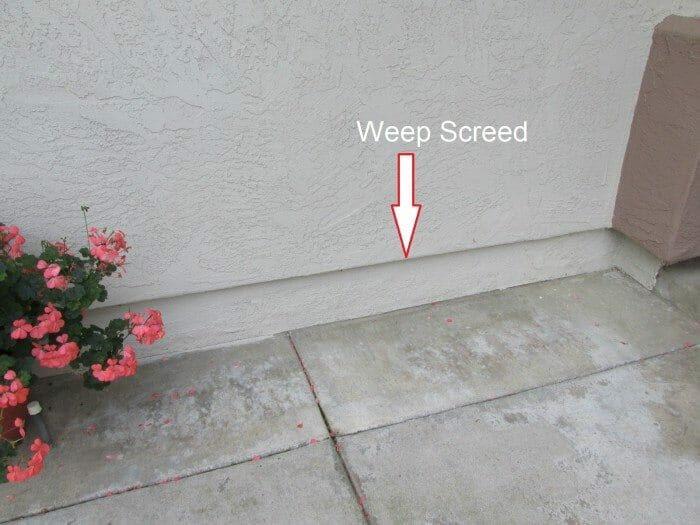
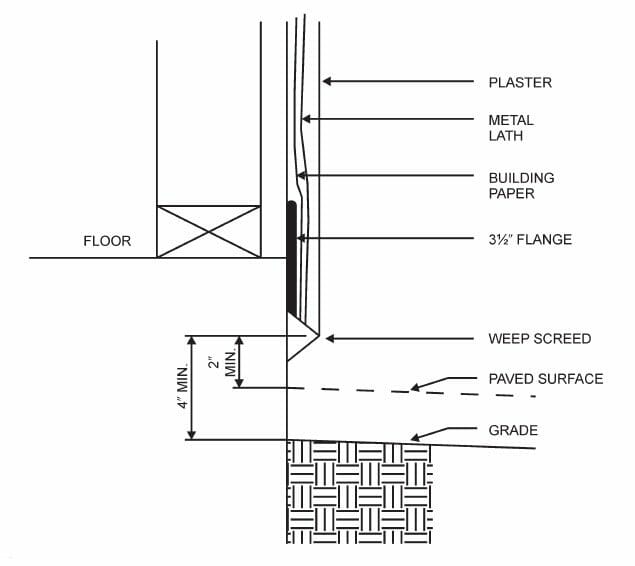
Many weep screeds have small holes in the bottom area of the screed. If there is a way you can visibly see the area and you see foam insulation, then it is generally an EFIS stucco system (in a few rare cases it may be a “One Coat” stucco system). If you only see a cementitious material and there is no foam materials, then more than likely it is a Traditional hard coat stucco wall.
Often it is difficult to see the underside, so some inspectors will use a flashlight with a mirror or use their cell phone to snap a photo of the area to see if there is evidence of foam.
#6 Other ways / the “Low Hanging Fruit”
- HOA. Do you have a Homeowners Association? If so, contact them and ask if your home has EFIS synthetic stucco or a Traditional 3 layer hard coat stucco cladding. Chances are the secretary will not know, but she may be able to direct you to someone that would know. It might be the builder or a property management company hired by the Homeowners Association.
- Stucco contractor. Call and ask a stucco contractor to stop by and tell you.
- General contractor. Have a local general contractor stop by.
- Building Department. Stop by the building department and inquire if they may be able to tell you. At times some of the building departments will have your house plans and will let you view them. If so, ask to see them. At times there is someone there that will take a quick look at them and tell you what type of cladding system you have.
- The Builder. Should you know who the builder was, a quick call to him may provide the answer for you.
- Neighbor. Occasionally a neighbor will know. Especially if there has been litigation over the stucco cladding of the homes in the neighborhood.
- Handyman. Ask a handyman to stop by and see if he knows.
- Previous owner. If you have the name and phone number, you might consider giving him or her a call and ask if they happen to know.
Special Notes
There is a “One Coat” stucco system that has foam board in it, similar to an EFIS synthetic stucco system.
When determining the type of stucco cladding you have on your house, you may occasionally run across a proprietary product (system) referred to as “One Coat” stucco. The reason people get confused, is that it has foam board in it similar to an EFIS system, so when they see evidence of a white Styrofoam type of foam board, they assume it is EFIS. However, the outer layer of a “One Coat” system is about 3/8 of an inch thick and is a blend of cementous stucco materials reinforced with fiberglass fibers. It is very hard, like Traditional 3 coat stucco. There is not a little give in it when you push on it. Seldom will a homeowner come across a “One Coat” system.
Foam trim and mouldings on Traditional hard coat stucco may lead to confusion in a few cases
It is very common for architects to use pre-manufactured pieces of foam and mouldings to architecturally highlight the features of a home. They will often use them around windows and doors, or for horizontal bands, or to form arches and key stones, quoins and other accent pieces. These foam pieces can be glued onto regular Traditional hard coat stucco or onto an EFIS synthetic stucco assembly; it’s hard to visually tell. Therefore, if a small chunk (i.e. two inches long and a ¼ of an inch deep) of the foam trim was knocked off, you would see exposed foam. However, it may be just a piece of foam trim that has been glued onto a Traditional hard coat stucco wall. Don’t let this mis-lead you.
Insurance. Note that there may be some insurance companies that do not cover EFIS synthetic stucco systems unless they meet specific requirements, or they may require a rider or a higher premium. Occasionally, questions regarding if a home has EFIS cladding and the year that the house was constructed may come up; therefore, it could be wise to know the type of stucco cladding you have.
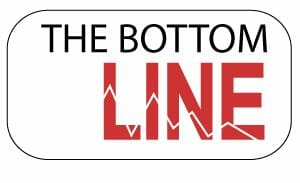
Knowing if your home has Traditional Hard Coat stucco or EFIS synthetic stucco cladding is critical when it comes to repairing it or fixing leaks.
One of the main reasons for this is that a EFIS synthetic stucco system repair is generally more complex than repairing Traditional Hard Coat stucco. Due the complexities of an EFIS system it usually requires higher levels of skills to do the repairs and an understanding of the components in the system, including the lamina.
The lamina is basically the base coat, mesh, and finish coat which serves as the initial defense against rain and moisture intrusion. EFIS systems require that only specific products be used, and they must meet specific ASTM standards and be installed per applicable codes.
Homes that have Traditional hard coat stucco are generally less complex to repair and often DIY homeowners will do repairs, fix cracks and seal leaks themselves. Additionally, the cost of repairs may be less.
